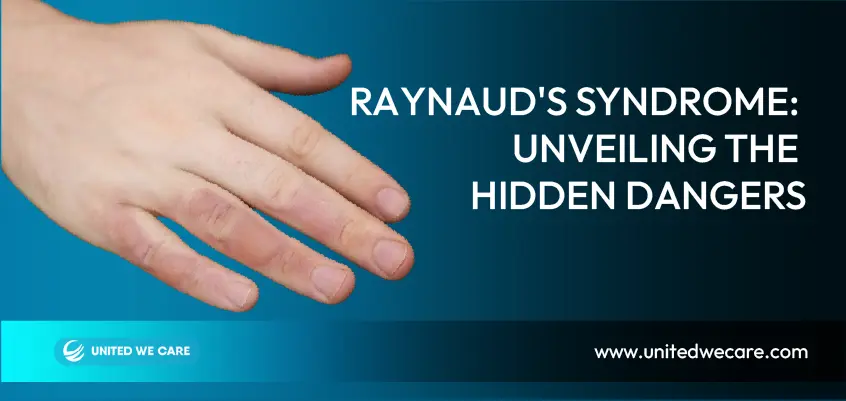Introduction
Raynaud’s syndrome is a vascular disorder in which individuals show an exaggerated response to cold temperatures or emotional stress. If an individual suffers from this syndrome, that individual may experience spasms in small blood vessels of the fingers, toes, and other extremities, temporarily disrupting the blood flow[1]. The affected areas where blood flow is disrupted may experience temporary changes in color white, blue, and red and feelings of discomfort, numbness, and tingling sensation.
What is Raynaud’s Syndrome?
Raynaud’s syndrome is a vascular disorder that affects blood vessels in the body’s extremities, like fingers and toes[1]. Generally, an individual will experience this situation of vasospasm, sudden and temporary contractions of small blood vessels as a response to cold temperatures or emotional stress[2].
During an episode of this syndrome, the affected areas may experience a series of color changes, progressing from white (pallor) due to reduced blood flow to blue (cyanosis) due to inadequate oxygenation and finally to red (rubor) as blood flow return these color changes by discomfort, numbness, tingling, and coldness in the affected areas[3][9].
The exact cause of why Raynaud’s syndrome occurs is still not fully known. Still, some studies suggest that the abnormal response of the blood vessels to cold temperatures or emotional stress is possibly due to an overactive sympathetic nervous system. This syndrome can occur independently( primary Raynaud’s) or can be associated with other underlying health conditions as a secondary condition. Other health conditions in which the symptoms of Raynaud’s disorder are evident are autoimmune disorders or connective tissue diseases[2].
To effectively manage the symptoms, it is essential to avoid cold temperatures or try to keep your hands and toes warm by wearing warm gloves and socks during cold weather. Certain medications that help improve blood flow or relax blood vessels are also useful to treat the condition. Still, it is necessary to consult a doctor before considering any such medicines and only take medicines to treat your situation if the doctor prescribes medicines. To prevent complications and manage the symptoms, regular follow-up with a healthcare professional is necessary[7].
What are the Symptoms of Raynaud’s Syndrome?
Some of the symptoms are[1][2][6]:
- Color Changes: During an episode of this syndrome, the affected areas, the fingers, toes, and sometimes nose or ears, may turn white or bluish. This color change is due to the decrease in blood flow in those parts. This is called pallor or cyanosis[9].
- Numbness or Tingling: In this syndrome, along with the color changes in fingers and toes, individuals may experience a sensation of numbness or tingling in those areas, and this is due to the reduced blood flow and oxygen supply to the tissues in those areas.
- Coldness or Chilliness: The affected areas, the fingers and toes, may feel noticeably colder than the rest of the body due to the constriction of blood vessels. This constriction limits the blood circulation and heat distribution.
- Pain or discomfort: Due to this condition, the blood flow is restricted in the fingers and toes. Restricted blood flow in fingers and toes may cause an individual to experience pain or discomfort in the affected areas. The pain in those areas can range from mild to severe, and the intensity may vary from person to person.
- Throbbing or Stinging sensation: During a vasospastic attack, individuals may feel a throbbing or pain as blood flow returns to the affected areas by a noticeable color change from blue to red or pink.
- Sensitivity to temperature changes: People with this syndrome may have heightened sensitivity to freezing temperatures. Exposure to even a mild cold can trigger an episode.
- Emotional triggers: Stress and emotional factors can also precipitate vasospastic attacks in individuals with this syndrome. People dealing with anxiety, fear, or other emotional stressors are more susceptible to experiencing Raynaud’s condition, as these emotional triggers can affect blood vessel constriction.
- Gradual Return to Normal Color: After an episode of Raynaud’s syndrome, the affected areas usually gradually return to their standard color, accompanied by a warming sensation. It may take several minutes to a few hours.
What are The Causes of Raynaud’s Syndrome?
The exact cause of this syndrome is not yet fully understood. However, several factors and underlying conditions are there that can contribute to the development of this condition. Some of the causes and potential triggers of this syndrome[1][2][3]:
- Primary Raynaud’s syndrome: In most cases, Raynaud’s syndrome occurs without an underlying disease or condition when it occurs alone without any underlying disease or condition, it is called primary Raynaud’s syndrome. This involves an exaggerated response of the blood vessels to cold temperatures or emotional stress[7].
- Secondary Raynaud’s syndrome: Secondary Raynaud’s syndrome may occur when an underlying medical condition is associated with the condition of Raynaud’s syndrome. The conditions that can cause or contribute to secondary Raynaud’s include[7]:
- Connective tissue disorders: Diseases such as systemic lupus erythematosus, scleroderma, rheumatoid arthritis, and Sjögren’s syndrome can lead to secondary Raynaud’s syndrome.
- Vascular disorders: Conditions affecting the blood vessels, such as atherosclerosis, Buerger’s disease, and vasculitis, can cause Raynaud’s syndrome.
- Occupational factors: Certain occupations or jobs that involve repetitive use of vibrating tools or exposure to vibrating machinery can increase the risk of developing Raynaud’s syndrome.
- Medications: Certain medications, such as beta-blockers, some chemotherapy drugs, and medicines that narrow blood vessels, can trigger or worsen Raynaud’s symptoms[8].
- Smoking: Smoking or exposure to tobacco smoke can constrict blood vessels and increase the risk of developing Raynaud’s syndrome[5].
- Injury or trauma: Injuries to the hands or feet, including frostbite, can lead to Raynaud’s syndrome.
- Family history: Raynaud’s syndrome may have a genetic component, as it often runs in families. Having a close relative with Raynaud’s syndrome increases the likelihood of developing the condition.
An underlying disease does not necessarily mean that Raynaud’s syndrome will occur. If you suspect you have Raynaud’s syndrome or are concerned about your symptoms, seeking medical advice for proper evaluation and diagnosis is recommended.
Read more about withdrawal symptoms of smoking
What Are Some Of The Available Treatment Options For Raynaud’s Syndrome?
The treatment of Raynaud’s syndrome aims to alleviate symptoms, prevent complications, and improve blood circulation. Treatment approaches may vary depending on the severity of symptoms and whether the condition is primary or secondary. Here are the standard treatment options for Raynaud’s syndrome[1][2]:
- Lifestyle modifications: Making lifestyle modifications such as dressing warmly, avoiding cold exposure, and practicing stress management techniques like relaxation exercises can protect against cold temperatures, minimize triggers, and reduce the frequency of vasospastic attacks in Raynaud’s syndrome.
- Medications: Medications such as calcium channel blockers, alpha-blockers, and topical nitroglycerin can relax blood vessels, improve blood flow, and reduce the frequency and severity of attacks in Raynaud’s syndrome[1][8].
- Avoiding triggers: Identifying and avoiding triggers that provoke vasospastic attacks, such as exposure to cold temperatures, emotional stress, or certain medications, can help manage symptoms effectively.
- Biofeedback therapy: Biofeedback techniques can help individuals learn to control their body temperature and blood flow, potentially reducing the frequency and severity of attacks.
- Occupational changes: If occupational factors contribute to Raynaud’s syndrome, modifying work conditions or using protective equipment, such as vibration-absorbing gloves, can help reduce symptoms.
- Surgery (in severe cases): Surgical procedures like sympathectomy (surgical interruption of nerves that control blood vessel constriction) may, in rare cases, cause severe Raynaud’s syndrome with tissue damage or ulcers.
Read more about the benefits of meditation.
Conclusion
Raynaud’s syndrome can cause episodes of reduced blood flow to the body’s extremities, like fingers and toes. Outbreaks of this condition are caused by cold temperatures or emotional stress. There are certain treatment options available that can help in reducing the symptoms of Raynaud’s syndrome. Like medication can help improve blood circulation and alleviate symptoms, wearing warm gloves and socks in the cold, avoiding triggers, and lifestyle modification can help reduce the symptoms. If you need guidance contact the experts at United We Care.
REFERENCES
[1] “Raynaud’s disease,” Mayo Clinic, 23-Nov-2022. [Online]. Available: https://www.mayoclinic.org/diseases-conditions/raynauds-disease/symptoms-causes/syc-20363571. [Accessed: 13-Jul-2023].
[2] R. L. Richards, “Raynaud’s syndrome,” Hand, vol. 4, no. 2, pp. 95–99, 1972.
[3] “Raynaud’s Phenomenon,” Hopkinsmedicine.org, 08-Aug-2021. [Online]. Available: https://www.hopkinsmedicine.org/health/conditions-and-diseases/raynauds-phenomenon. [Accessed: 13-Jul-2023].
[4] Wikipedia contributors, “Raynaud syndrome,” Wikipedia, The Free Encyclopedia, 09-Jun-2023. [Online]. Available: https://en.wikipedia.org/w/index.php?title=Raynaud_syndrome&oldid=1159302745.
[5] “Raynaud’s disease and Raynaud’s syndrome,” WebMD. [Online]. Available: https://www.webmd.com/arthritis/raynauds-phenomenon. [Accessed: 13-Jul-2023].
[6] NIAMS, “Raynaud’s phenomenon,” National Institute of Arthritis and Musculoskeletal and Skin Diseases, 10-Apr-2017. [Online]. Available: https://www.niams.nih.gov/health-topics/raynauds-phenomenon. [Accessed: 13-Jul-2023].
[7] “Raynaud’s,” nhs.uk. [Online]. Available: https://www.nhs.uk/conditions/raynauds/. [Accessed: 13-Jul-2023].
[8] “Raynaud’s disease,” Blood, Heart and Circulation, 1999.
[9] A. Adeyinka and N. P. Kondamudi, Cyanosis. StatPearls Publishing, 2022.










